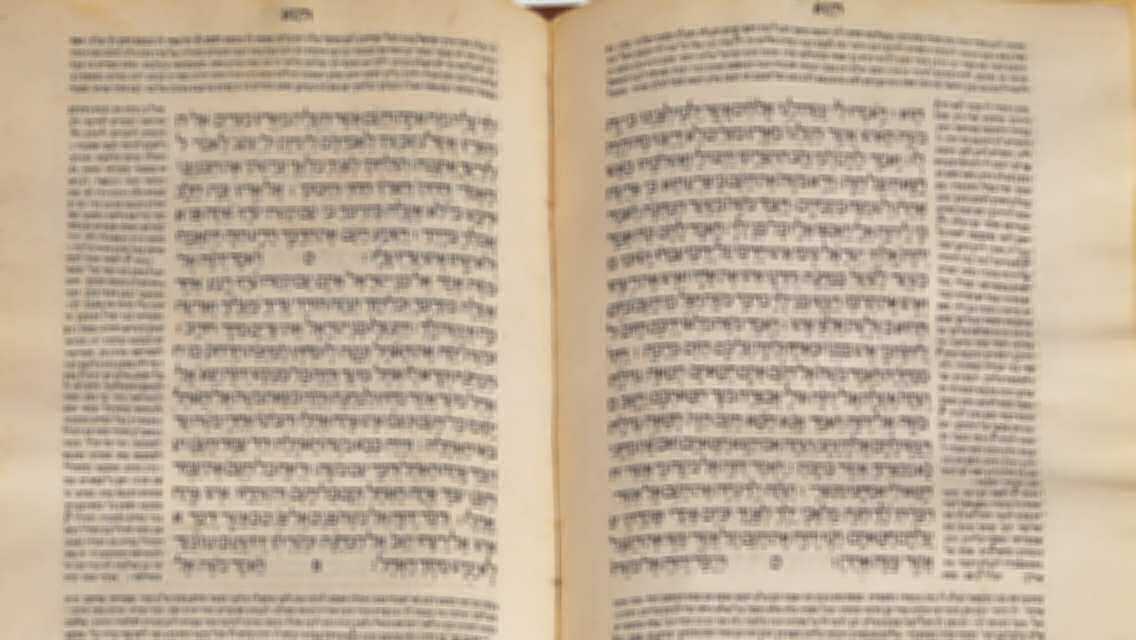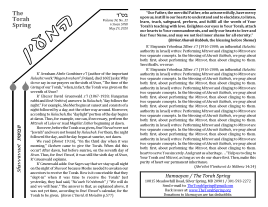This Week’s Sponsors
Sponsored by
Faith Ginsburg
on the yahrzeit of her grandfather
William Lavin
Avraham Zev ben Raphael a”h (15 Tishrei)
Martin and Michelle Swartz
on the yahrzeit of his mother
Lotte H. Meers a”h (16 Tishrei)
Why does Sukkot follow so closely after Yom Kippur? Not only are they close to each other on the calendar, they are connected by the Halachah that one should build part of his Sukkah on Motzai Yom Kippur / the night when Yom Kippur ends. Why?
R’ Moshe Eisemann shlita (former Mashgiach Ruchani of Ner Israel in Baltimore, Maryland) explains: Our Sages refer to Yom Kippur as a day of salvation or liberation. A gift such as liberation brings with it responsibility, and it must be cherished and nurtured. It also must be protected. Thus, it is no coincidence that the first stop that Bnei Yisrael made after their liberation at the Exodus was at a place called “Sukkot.” Thereafter, they were protected by the Clouds of Glory, which our Sukkot commemorate. For the same reason, every night in Ma’ariv, we recite the blessing, “Ga’al Yisrael” / “The One who redeemed Yisrael,” and then we pray, “And spread over us the Sukkah of Your peace.” And, after Yom Kippur, we hurry into our Sukkot.
R’ Eisemann continues: The Sukkah extends our Yom Kippur experience. On Yom Kippur, the Shechinah was with us. At the conclusion of that holiday, the Shechinah departs, so we build a Sukkah and invite it back. The Sukkah protects what we accomplished on Yom Kippur. How so? By placing the imprint of sanctity on everything we do in ordinary life. We eat in the Sukkah, drink in the Sukkah, sleep in the Sukkah, relax in the Sukkah, etc. Everything is sanctified. Therefore, Sukkot, R’ Eisemann writes, tells us how a “Yom Kippur Jew” looks. (The Themes of the High Holiday Machzor p.162)
“Corruption is not His--the blemish is His children’s, a perverse and twisted generation.” (32:5)
The words “not His” are written in Hebrew: “אל ול” (Lamed-Vav = His, Lamed-Aleph = not).
R’ Yeshayahu Yaakov Halevi z”l (18th century; rabbi of Olesko, Galicia) writes: We read in Tehilim (100:3--recited in Pesukei D’zimra on weekdays), “He made us and we are Lo, His people and the sheep of His pasture.” The word “Lo” is written Lamed-Aleph (“not”), but read Lamed-Vav (“His”), teaching that, when we are worthy, we are “His,” and when we are not worthy, we are “not” His. Our verse can be interpreted similarly, R’ Yeshayahu Yaakov writes, teaching that our corruption can change Lamed-Vav (“His”) to Lamed-Aleph (“not”), G-d forbid. (Atzei Eden)
“Is it to Hashem that you do this, vile and unwise people? Is He not your Father, your Master? Has He not created you and established you?” (32:6)
R’ Shlomo Eliasof z”l (1841-1926; leading early 20th century kabbalist; grandfather of R’ Yosef Shalom Elyashiv z”l) writes: It is a given that our Mitzvot and sins have no impact on Hashem, as we read (Iyov 35:6-7), “If you have sinned, how have you affected Him? If your transgressions multiply, what have you done to Him? If you were righteous, what have you given Him, or what has He taken from your hand?” Thus, our verse’s question (“Is it to Hashem that you do this?”) is not asking whether our sins impact Him. Rather, it is asking, “How could you sin against Hashem after all the good that He gives you? Is that how you repay Him?”
R’ Eliasof continues: Everything Hashem created, He created only for us. We are like people for whom a benefactor built a magnificent mansion surrounded by beautiful gardens, who, through our sins, loot and destroy what was built for us. When we prevent Hashem from showering us with goodness, we are hurting only ourselves.
R’ Eliasof asks: How, then, are we to understand the blessing (one of the Sheva Berachot recited at and after a wedding), “He created everything for His honor”? He explains: Hashem does not need honor from us. Rather, the greatest “light” and the greatest pleasure that a person can attain is the closeness to Hashem that comes from honoring Him. Hashem created everything so that we can benefit from honoring Him! (Quoted in Niglot Leshem Shvo V’achlamah)
“You would drink blood of grapes like delicious wine.” (32:14)
In the laws of Taharah and Tum’ah / ritual purity and impurity, there is a certain significance to seven liquids, including water and wine. R’ Moshe ben Maimon z”l (Rambam; 1135-1204; Spain and Egypt) and others write that wine’s status as a Halachic liquid is derived from our verse.
R’ Dov Ber Treves z”l (rabbi of Vilna in the days of the Vilna Gaon; died 1803) asks: Drinking wine is mentioned a number of times in the Torah before this, beginning with (Bereishit 9:21), “He [Noach] drank of the wine . . .”! What is special about our verse?
R’ Treves answers: In Talmudic times, wine was diluted with water before it was consumed. Perhaps, then, all of the Torah’s references to drinking wine also refer to wine diluted with water. If so, one cannot derive from those references that wine alone is considered a Halachic liquid. Here, however, the verse refers to wine as “the blood of grapes”--clearly a reference to drinking undiluted wine. (Revid Ha’zahav)
“Were they wise they would comprehend this, they would discern it from their end.” (32:29)
R’ Aharon Lewin z”l Hy”d (the Reisher Rav; killed in the Holocaust) writes: The Gemara (Kiddushin 30a) teaches that the words “Darosh darash” / “he inquired and inquired again” (Vayikra 10:16) are the middle words of the Torah. The central place given in the Torah to “inquiring and inquiring again” hints to the fact that one of the primary causes of sin is hurrying--failing to take the time needed to comprehend and discern the consequence of one’s decisions. This is alluded to as well in Kohelet (7:8), “The end of a matter is better than its beginning.” R’ Lewin writes: This verse also may be translated: “The end of a matter is better from its beginning,” i.e., our choices turn out best if, from the beginning, we take the time and put in the effort to foresee the end of the course of action on which we are embarking. (Ha’drash Ve’ha’iyun)
“‘Is it not revealed to Me, sealed in My treasuries? Mine is vengeance and retribution at the time when their foot will falter . . . When Hashem will have judged His people, He shall relent regarding His servants . . .” (32:34-36)
R’ Yaakov Moshe Charlap z”l (rabbi of Yerushalayim’s Sha’arei Chessed neighborhood and Rosh Yeshiva of Yeshivat Merkaz Harav; died 1952) explains: Hashem has a secret. On the one hand, His judgment overlooks nothing (“Mine is vengeance and retribution”). On the other hand, even if we hit rock bottom, Hashem will have a way to redeem us despite our sins (“He shall relent regarding His servants”). How both statements can be true is revealed only to Him, sealed in His treasuries. (Mei Marom Vol. V)
Sukkot
“On Hoshana Rabbah, they circled the Mizbei’ach / altar seven times. Rabbi Acha said: ‘As a remembrance of Yericho’.” (Talmud Yerushalmi: Sukkah 4:3)
When Bnei Yisrael entered Eretz Yisrael, the first city they conquered was Yericho. They did this by circling Yericho once each day for six days, then seven times on the seventh day, whereupon the city’s walls collapsed. Paralleling this, when the Bet Hamikdash stood, a procession circled the Mizbei’ach one time on each of the first days of Sukkot and seven times on Hoshana Rabbah. In turn, we recall that practice on the seven days of Sukkot by circling the Bimah in Shul a similar number of times while reciting Hoshanot.
What is the connection between the conquest of Yericho, which took place in Nissan, and Hoshanot on Sukkot?
Rabbeinu Bachya ben Asher z”l (Spain 1255-1340) explains: On Sukkot, we sacrifice a total of 70 oxen--13 the first day, 12 the second day, etc. Those oxen parallel the 70 nations of the world, and the decreasing number offered each day alludes to the eventual disappearance of those nations. (Some explain that this refers to mankind’s eventual unification under the one, true G-d, at which time there will no longer be separate nations.) A procession marching in a circle likewise alludes to the disappearance of the nations, as is evident from the fact that that is how Yericho--the first place in Eretz Yisrael conquered by Bnei Yisrael--fell.
R’ Shmuel Eliezer Eidels z”l (Maharsha; Poland; 1555-1631) writes: The purpose of Hoshanot is to seek Hashem’s protection from our enemies. (The word “Hoshana” means “Please rescue [us].”) That was the very same thing that Bnei Yisrael sought when they circled Yericho.
Some explain the parallel between Yericho and Hoshanot as relating to the fact that the War of Gog and Magog will be fought on Sukkot and will culminate on Hoshana Rabbah. [That is why two of the Haftarot that we read on Sukkot relate to that war.] We allude in our prayers to Yericho, the first of our battles in Eretz Yisrael, as a surrogate for the final battle. Some say that that battle will take place on the plains surrounding Yericho. (Quoted in Otzar Mefarshei Hoshanot pp. 28-31)
With gratitude to Hashem,
and thanks to our readers and supporters,
this concludes the thirty-sixth cycle of Hamaayan.
Find Other Issues
Hama'ayan's archives are being rebuilt. Check back soon.

